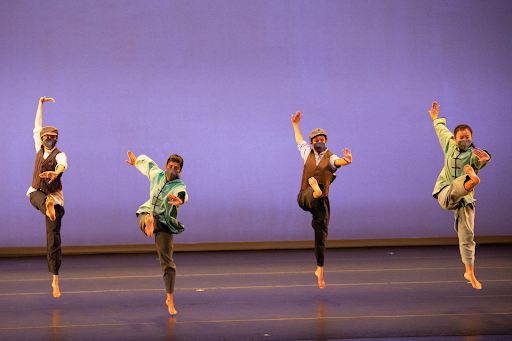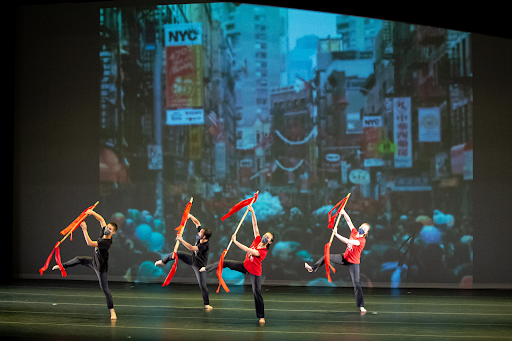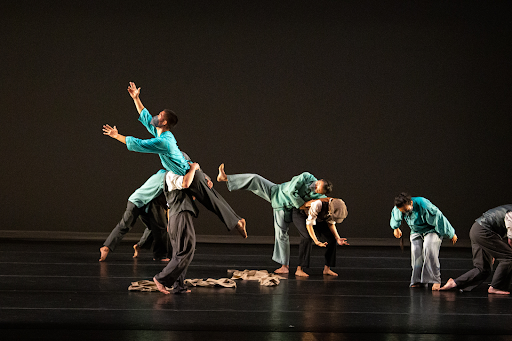H.T. Chen & Dancers return to campus
October 27, 2021

Whirling around the stage, one arm outstretched holding a red lantern and the other clenched in a fist at the waist, the members of H.T. Chen & Dancers demonstrated their unique modern dance technique on the main stage of the ’62 Center for Theatre and Dance on Oct. 15. The company performed an hour-long program inspired by Asian American heritage, including an excerpt of Hidden Voices, a dance drawn from the experiences of Chinese workers during a North Adams factory strike in the 1870s.
H.T. Chen & Dancers is a touring dance company based in New York City that performs modern works nationally and internationally. The company’s co-choreographers, H.T. Chen and Dian Dong, met while they were students at Juilliard. As Dong explained as she introduced the program, once they graduated, they felt the need to work within their own Asian American communities. They founded the Chen Dance Center, and today they incorporate Asian American history into their performances, programming, and community outreach.
As a warm-up, the company dancers displayed modified tai chi movements. Holding invisible balls of energy and pushing imaginary mountains from side to side, the performers engaged their muscles through imagined resistance by the mind.
Next, twirling a long pole parallel to his body, one of the dancers demonstrated the idea of planal organization — the idea that the space around our bodies can be categorized into vertical, horizontal, and diagonal planes — that influences the company’s technique. The “short pole form,” which employs a shorter pole than in the previous section, the dancers constructed their movements around the positioning of the pole, holding it over their heads or using it as an anchor to the floor.

Finally, the company performed an excerpt of Hidden Voices, a piece originally commissioned by and performed at the College in 1993. The professional dancers shared the stage with four students at the College, all of them members of the Williams Contemporary Dance Ensemble (CoDa) — Ashley Xu ’22, Keshini Cardozo ’24, Beam Maskati ’25, and Sadie Fernandez ’25.
Per the company’s website, Hidden Voices tells the story of Chinese workers in North Adams, whom factory owners brought to the town as strikebreakers in the late 1870s. Dancers portraying local strikers and immigrant strikebreakers fought in choreographed chaos set to energizing music. They battled over bowls, representing the Chinese laborers’ personal possessions, and aprons, representing the jobs themselves.
The choreography reflected the racist backlash that the Chinese workers faced upon arriving in North Adams; they were supposed to stay with local families but were instead greeted by angry townspeople. North Adams locals resented the Chinese workers for accepting the jobs, despite the fact that the strikebreakers were paid half the wages of the former workers. The Chinese workers were thus forced to live in the factory in which they worked. The strike lasted for three years, after which both groups worked together.
In rehearsals, Chen explained how each move related to a specific part of the story. “For example, there was one part where we did bourrées [a dance involving quick, small steps] and [Chen] emphasized that the sound was supposed to be like a sewing machine in the factories,” Cardozo said.

H.T. Chen & Dancers has had a long association with the College. The College sponsored the 1993 on-site research and inception of Hidden Voices. In 2016, the company did a residency at Williams, performing a piece called South of Gold Mountain, which explored the history and hardships of Chinese immigrants living in the South. Co-Artistic Director of CoDA Erica Dankmeyer, worked with the company while they were visiting in 2016, and again during this year’s visit.
To prepare for this year’s performance, the company initially sent over videos of the choreography, which Dankmeyer then taught to the student performers. She said working with the company illustrated the importance of collaboration in dance.
“I really came away from this project with a real realization about the art and craft of incorporating students into work that is already made,” Dankmeyer said. “It was really quite an undertaking. It made me very optimistic and excited, which often happens with dancers at Williams.”
Participating in this performance was also meaningful to the student performers. “Being a part of a piece that means so much to local history and stands for social justice … contributed to how wonderful the whole experience was,” Xu said.







